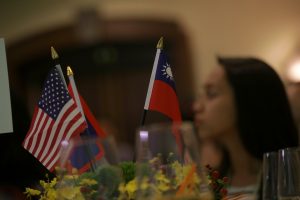On February 16, 2025, the U.S. State Department quietly updated its fact sheet on Taiwan-U.S. relations, removing the long-standing phrase: “we do not support Taiwan independence.”
At first glance, this might seem like a minor bureaucratic change. But in the context of China-U.S. strategic rivalry, the revision could carry far-reaching geopolitical consequences. It raises critical questions: Is Washington deliberately testing Beijing’s red lines on Taiwan? Is this a temporary shift to gain leverage in China-U.S. negotiations? Or does this mark the beginning of a more defined U.S. approach to Taiwan’s status?
While the Biden administration made a similar revision in 2022 – only to walk it back after China’s diplomatic protests – the Trump administration’s latest move signals a willingness to take risks in Taiwan policy. Whether this is a calculated shift or a flexible bargaining tool, Beijing, Taipei, and Washington must now recalibrate their strategies.
From Strategic Ambiguity to Strategic Adjustment?
For decades, the U.S. has followed a carefully balanced One-China Policy, shaped by three key documents. The Shanghai Communiqué (1972), issued during President Richard Nixon’s visit to China, acknowledged, but did not endorse, Beijing’s claim over Taiwan. The Taiwan Relations Act (1979) – passed by Congress after the Carter administration severed formal ties with Taiwan and recognized the People’s Republic of China – mandated U.S. arms sales to Taiwan for self-defense. The Six Assurances (1982), originally made in diplomatic cables to Taiwan, reaffirmed (among other points) that Washington would not pressure Taiwan into negotiations with Beijing.
This framework allowed Washington to deter both Chinese aggression and unilateral Taiwanese moves toward independence, preserving the cross-strait status quo. The removal of the “not supporting Taiwan independence” phrase suggests a subtle recalibration – one that could either reinforce or weaken strategic ambiguity.
Adding to the significance of this shift, Washington also revised its stance on Taiwan’s participation in international organizations. Previously, the State Department specified that Taiwan could only join organizations where statehood was not a requirement. Now, the factsheet states that the U.S. supports “Taiwan’s meaningful participation in international organizations, including membership where applicable.”
This linguistic tweak may indicate that Washington is open to pushing for Taiwan’s inclusion in organizations that require sovereignty – such as the United Nations – a move Beijing considers a direct challenge to its sovereignty claims.
Beijing’s Response: “A Serious Regression”
China was swift to condemn the revision. In a press conference on February 17, Chinese Foreign Ministry spokesperson Guo Jiakun said the U.S. had “gravely backpedaled on its position on Taiwan-related issues” and accused Washington of sending a “seriously wrong signal” to separatist forces in Taiwan.
“This is another example of the U.S. clinging to its wrong policy of ‘using Taiwan to contain China,’” Guo said. “We urge the U.S. to immediately correct its wrongdoings…”
This comes amid China’s increasing legal crackdown on what it considers separatist activities. Last year, Beijing issued a new legal opinion on separatism, stating that promoting Taiwan’s entry into international organizations that require statehood constitutes “an act of Taiwan independence.”
This raises an important question: Will China interpret the U.S. revision as direct support for Taiwan independence?
If Beijing sees this as a break from strategic ambiguity, it could respond in a variety of ways. China could increase military activity near Taiwan, including large-scale exercises and gray-zone tactics. Beijing could step up economic coercion, targeting U.S. or Taiwanese firms as a warning. It could also retaliate diplomatically, potentially downgrading China-U.S. engagement or escalating tensions at international forums.
Given Beijing’s previous responses to perceived U.S. provocations, military signaling – such as fighter jet incursions into Taiwan’s air defense zone – is the most likely immediate reaction.
Taipei’s Political Divide: DPP vs. KMT
Taiwan’s ruling Democratic Progressive Party (DPP) enthusiastically welcomed the U.S. revision. The DPP’s party charter explicitly states its goal of establishing a sovereign Republic of Taiwan. The previous U.S. stance against Taiwan independence has long been a political obstacle for the party.
Taiwan’s Ministry of Foreign Affairs thanked Washington for its “positive, Taiwan-friendly wording,” framing it as a step toward greater international recognition. The DPP will likely use this shift to further its diplomatic push for expanded global participation.
For the opposition Kuomintang (KMT), the shift presents a more complicated challenge. The KMT maintains that both sides of the Taiwan Strait are part of China, but that the Republic of China (ROC) remains the only legitimate government.
Historically, the KMT rejected Taiwan independence while citing U.S. policy as proof that formal independence was unrealistic. Now that the United States has softened its language, the KMT faces a messaging dilemma. It cannot support Taiwan independence, as that contradicts its cross-strait stance. But it also cannot be seen as opposing stronger Taiwan-U.S. ties, which many Taiwanese voters support.
This puts the KMT in a delicate balancing act as it navigates Taiwan’s domestic political landscape ahead of future elections.































